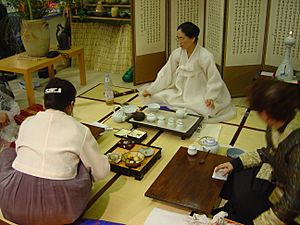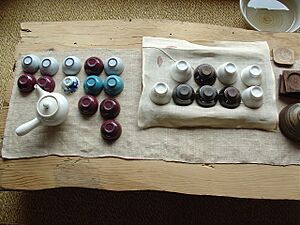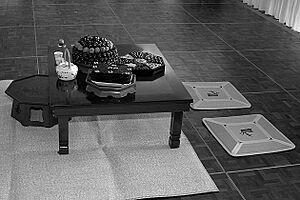Korean tea ceremony facts for kids
| Korean tea ceremony | |
 |
|
Quick facts for kids Korean name |
|
|---|---|
| Hangul |
다례
|
| Hanja | |
| Revised Romanization | darye |
| McCune–Reischauer | tarye |
The Korean Tea Ceremony is also called darye (다례). This traditional ceremony from Korea is a special way of enjoying tea. The word darye means "etiquette for tea" or "tea rite." Koreans have practiced it for over a thousand years. The main idea of the Korean tea ceremony is to enjoy tea in a relaxed and natural way, even though there are some formal steps.
Today, tea ceremonies are becoming popular again in Korea. They help people find peace and balance in their busy lives. It's a way to keep a long tradition of Korean art alive.
Contents
History of Tea Ceremonies
How Tea Ceremonies Started
The first time we find a record of tea being used in a ceremony was in the year 661. People offered tea to the spirit of King Suro, who founded the Geumgwan Gaya Kingdom. Later, during the Goryeo Dynasty (918-1392), tea was offered in Buddhist temples to honor important monks.
Government officials from a special department called "Tabang" led important national tea rituals. One such ritual was for welcoming Chinese messengers to the court.
Tea During the Joseon Dynasty
During the Joseon Dynasty (1392-1910), tea drinking continued and became even more refined. The "Tabang" department still organized royal tea ceremonies. The royal family and nobles used tea for simple rites. The "Day Tea Rite" was a common daytime ceremony. The "Special Tea Rite" was for important events like royal weddings or welcoming visitors. These ceremonies were written down in a book called "National Five Rites" in 1474.
However, growing tea in Korea had problems. The climate was colder than in China or Japan. Tea harvesting happened in early spring when mountains were still cold and dangerous due to wildlife. The old Korean name for tea, "Seollok" (설록), means tea leaves picked from snowy mountains. This made it hard to grow tea during the Goryeo and Joseon Dynasties.
Tea-growing areas were also Korea's main farming regions. The tea harvest time overlapped with planting grains. Because tea was valuable, farmers in these areas paid high taxes to the King. This led to farmers burning or cutting down their tea trees to protest the taxes. This is recorded in a book called "Yuduryurok."
In the Joseon Dynasty, which followed Confucianism, the "Tabang" department continued tea ceremonies. But they reduced tea production to protect farming. This stopped the tea industry from growing for a long time. So, outside of the royal family and nobles, tea drinking mostly stayed in areas where tea trees grew.
By the middle of the Joseon Dynasty, tea drinking became less common, except for special ceremonies. It is said that King Seonjo (who ruled from 1567-1601) once said, "We do not have a tea drinking custom in our country."
Tea After the Joseon Dynasty
Towards the end of the Joseon Dynasty, regular people also started using tea for family ceremonies. Scholars like Jeong Yak-yong and Kim Jeong-hui became interested in tea while living in tea-growing regions. They connected with monks who still practiced tea culture. Monks had grown and managed tea forests around their temples since the Silla and Goryeo Dynasties. Buddhist tea ceremonies became a special tradition in temples. The connection between scholars and monks influenced both groups.
Tea Since the 1960s
Until the 1960s, tea culture was rare in Korea. In the 1960s, Choe Kilsung found that some temples still had their own tea gardens. In the 1970s, a "Korean Tea Culture Revival Movement" began. In 1973, Lee Gwilye started researching old tea traditions. In 1979, she founded the Korean Tea People's Association.
It's hard to find old books that fully describe how Korean tea ceremonies were done.
Equipment for Tea Ceremonies
The tools used in Korean tea ceremonies change with the seasons. The type of ceramics and metalware also depends on religious traditions.
Simple Stoneware and earthenware were common. These were often made in local kilns. Porcelain was rare, and royal porcelain with dragon designs was the rarest. You can see examples of these tools in articles about Korean Ceramics and Korean pottery.
Historically, tea bowls and cups looked natural. Their appearance often showed religious influences:
- Celadon (jade green) or bronze-like colors were used for Buddhist tea rituals.
- Pure white porcelain with light designs was for Confucian tea rituals.
- Rougher porcelains and ash-stone glazes were for animist rituals or for export to Japan.
People especially liked rough surfaces made from clay and sand with a thin glaze. This natural, random look was valued by tea masters.
The glazes on the pottery have rich textures and many color changes depending on the light and season. The clay used was usually light, and celadon clays were highly prized.
Glazing techniques could make pottery look like many different materials. These included bamboo, river pebbles, tree bark, or even human skin. Some unique glazes looked like tiger's eye, peaches, or deep snow. These designs helped people remember seasons, poems, or peaceful moments.
The style of pottery, glazes, and shapes changed over time. Old designs are still used today. Korean potters like Yi Sukkwang and Yi Kyeong shared their traditional styles abroad, which became known as "Hagi" styles. Different pottery families and local kilns created unique glazes. The deep colors of these glazes show the best middle Joseon jagi (Joseon wares).
Seasonal Tea Equipment
- Summer tea equipment: Used "katade" bowls, which were about 5 cm tall and 12 cm wide. Their wide shape helped cool boiled water faster. Hot water was poured into these bowls, cooled a bit, then poured into a teapot. This cooling step is important because very hot water can make tea taste bitter. The tea was then poured into smaller matching cups with covers. Guests would lift the cup cover while drinking. Summer tea was enjoyed cool.
- Autumn and winter tea equipment: Used taller, narrower bowls, like the "irabo" style. These bowls kept the tea hot. They were often spiral-shaped, shallow, with a high rim. Tea made in these bowls was then poured into heated teapots. From there, it was poured into smaller matching cups with covers. Tea was enjoyed hot. It was poured in small amounts from cup to cup to make sure the flavor was even in all cups.
Unlike Chinese tea traditions, Korean tea vessels are not tested for a musical sound. Instead, they are judged on their natural shape, feeling, and color.
A Natural Way to Enjoy Tea
The Korean way of tea focuses on being easy and natural. There are fewer strict rules and more freedom to relax. People can be creative and enjoy many different teas, services, and conversations.
This means you'll find a wide variety of teahouse designs, tea gardens, and styles of teaware. There are also regional differences in tea choices, snacks, and the atmosphere of teahouses.
Tea storage containers were often large. They were made from clay, shaped on potter's wheels, and partly glazed inside by the wood fire in the kiln. Natural green ash glazes were common. A long-handled wooden scoop, often made from split bamboo, was used to get the tea.
The best local water is usually used for tea. Some of the best Korean teahouses even have their own small springs. Water is boiled over a wood fire, poured into a teapot, and served right away.
The tea hostess pours tea into warmed cups from a heated teapot. She holds the teapot high above the first cup to create a controlled flow with attractive bubbles. This is believed to bring good luck.
Tea ceremonies are used for important events like birthdays, anniversaries, and remembering old friends. They are also a way to rediscover the peace of Seon meditation.
Since Korean tea was often green tea, even small leaves were rare.
Modern Tea Ceremony Steps
One modern version of the Korean tea ceremony uses a low tea table. Guests and the tea master sit around it. The tea master, or host, sits on one side. They heat, pour, and clean the tea ware throughout the ceremony. The host often keeps all the tea ware on the table year-round, covering it with a cloth when not in use. The collection might include several teapots and many different colored and shaped teacups.
The ceremony begins with everyone sitting around the table. As the water heats, the host starts a casual conversation, perhaps asking about the guests' families.
The host officially begins by heating the pot, cups, and a special pouring bowl with hot water. After this, they put tea leaves (usually green tea) into the pot. Then, the host pours hot water over the leaves and quickly pours it out. This rinses the leaves and helps them open up. Next, the host pours hot water into the pouring bowl and lets it cool to the right temperature for the tea. The correct temperature depends on when the tea was picked. Tea picked early in the season (like in early April) needs cooler water (about 60-65°C or 140-149°F). Tea picked in June needs hotter water (about 70-75°C or 158-167°F).
Once the water is at the right temperature, the host pours it into the pot. The tea steeps for 20 seconds to three minutes, depending on the type. After steeping, the host pours the tea into the pouring bowl. This gets the water off the leaves and mixes the tea evenly. Finally, the tea is poured into the cups. Guests wait for the host to pick up their cup first before picking up their own. This process can last for several hours. The whole ceremony is very relaxing and a great way to get to know someone or to start a business discussion.
Kinds of Tea Used
The earliest teas used in ceremonies were heavily pressed cakes of black tea. These were like aged pu-erh tea, which is still popular in China. Older teas were valued, and very old tea imported from China was popular in the royal court. However, Buddhist monks brought more delicate tea plants to Korea, which changed the tea ceremony.
While green tea, called "chaksol" or "chugno," is most often served, other teas can be used. These include "Byeoksoryung" Chunhachoon, Woojeon, Jakseol, Jookro, Okcheon. Also, native teas like chrysanthemum tea, persimmon leaf tea, or mugwort tea might be served at different times of the year.
Korean teas were described by five different tastes: bitterness, sweetness, astringency, saltiness, and sourness. Most Korean teas are enjoyed as fresh as possible, especially new harvests.
Tea regions were known for producing teas with special combinations of these five tastes. For example, teas from Jeju Island often have more saltiness due to ocean winds. Other tastes come from how the leaves are cooked or the hardness of the water.
For Korean Buddhists, teas also bring out four qualities: peacefulness, respectfulness, purity, and quietness. Teas that highlight these qualities are highly valued.
Types of Tea Ceremonies
Buddhist monks included tea ceremonies in their offerings. Later, the Goryeo nobles and Confucian scholars made the rituals more formal and beautiful.
There are at least 15 main tea ceremonies. Here are some of the most famous:
- Day Tea Rite: A daily palace tea ceremony during the Joseon Dynasty.
- Special Tea Rite: A Joseon Dynasty ceremony for welcoming foreign visitors, trade missions, and for royal weddings.
- Queen Tea Ceremony: A special tea ceremony sometimes shown in Korean TV shows. It was only for the Queen's women friends, family, and servants, but often included the Crown Prince.
Matcha, which is powdered green tea, has also been somewhat popular in Korea. Tea leaves ground into a very fine powder are usually linked to the Japanese Tea Ceremony. But in Korea, this type of tea has gained some respect, especially among Buddhists. Myeong-san cha, or meditation tea, is a form of meditation itself. It was said to be popular among monks who meditated for many days without sleep. Matcha has more nutrients than regular leaf tea. Because the whole tea leaf is consumed, it contains higher amounts of vitamin C, tannins, and polyphenols.
With the rise of Christianity in Korea, some people see this meditation tea as only Buddhist and avoid it. However, true "da-in" (tea people) enjoy the physical and mental benefits of matcha.
Bringing Back Traditional Tea Ceremonies
Modern times have seen a revival of traditional Korean tea culture and ceremonies. Myung Won, Kim Mi-Hee, was a key figure. In 1979, she held the first Korean tea culture research conference. In 1980, she publicly showed the full steps of traditional Korean tea ceremonies at the Sejong cultural center. She helped bring back royal court tea ceremonies, Buddhist temple tea ceremonies, guest greeting tea ceremonies, and everyday tea ceremonies. Today, her second daughter, Kim Eui-Jung, continues these traditions. She is recognized as Intangible Cultural Asset 27 of Seoul for the Royal Court Tea ceremony.
People are becoming more aware of the health benefits of tea and the importance of traditional culture. This has led to a growing interest in Korean tea culture and tea ceremonies today.
Modern Tea Revival at Panyaro Institute
The Panyaro Institute was founded to continue the work of a famous Korean Tea Master named Venerable Hyodang. He spent sixty years studying the teachings of the great Korean spiritual master Wonhyo. He also developed ways to use tea in meditation.
Hyodang helped tea culture in three main ways: 1. He wrote the first Korean book about the Way of Tea, called "The Korean Way of Tea." This book still inspires people interested in Korean tea culture. 2. He shared a special method for making green tea known as Panyaro. 3. He started the first group for Koreans interested in studying tea, called the "Korean Association for the Way of Tea."
Hyodang was also the first to help everyday readers understand the importance of Venerable Ch'o-ui, a tea master from the early 1800s. He did this through articles in a popular newspaper. Just as Ch'o-ui led a tea revival in his time, Hyodang led the modern revival.
In 1981, Chae Won-hwa started what became the Panyaro Institute. By November 1995, she had created a formal graduation ceremony for those who completed the full course of study. These ceremonies are now held every year.
See also
 In Spanish: Ceremonia coreana del té para niños
In Spanish: Ceremonia coreana del té para niños



